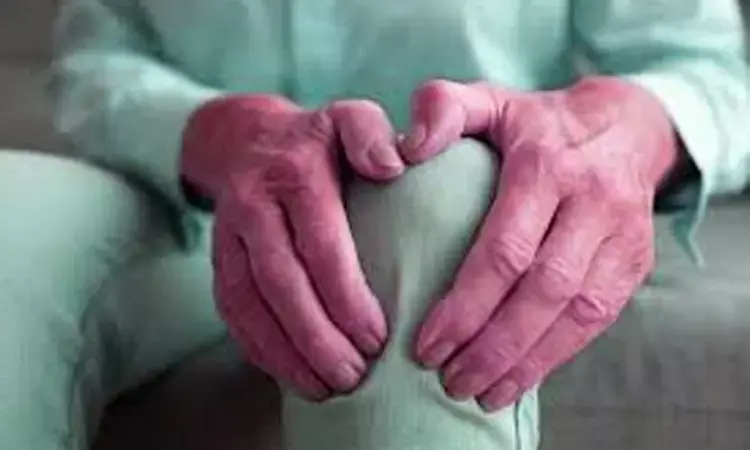- Home
- Medical news & Guidelines
- Anesthesiology
- Cardiology and CTVS
- Critical Care
- Dentistry
- Dermatology
- Diabetes and Endocrinology
- ENT
- Gastroenterology
- Medicine
- Nephrology
- Neurology
- Obstretics-Gynaecology
- Oncology
- Ophthalmology
- Orthopaedics
- Pediatrics-Neonatology
- Psychiatry
- Pulmonology
- Radiology
- Surgery
- Urology
- Laboratory Medicine
- Diet
- Nursing
- Paramedical
- Physiotherapy
- Health news
- Fact Check
- Bone Health Fact Check
- Brain Health Fact Check
- Cancer Related Fact Check
- Child Care Fact Check
- Dental and oral health fact check
- Diabetes and metabolic health fact check
- Diet and Nutrition Fact Check
- Eye and ENT Care Fact Check
- Fitness fact check
- Gut health fact check
- Heart health fact check
- Kidney health fact check
- Medical education fact check
- Men's health fact check
- Respiratory fact check
- Skin and hair care fact check
- Vaccine and Immunization fact check
- Women's health fact check
- AYUSH
- State News
- Andaman and Nicobar Islands
- Andhra Pradesh
- Arunachal Pradesh
- Assam
- Bihar
- Chandigarh
- Chattisgarh
- Dadra and Nagar Haveli
- Daman and Diu
- Delhi
- Goa
- Gujarat
- Haryana
- Himachal Pradesh
- Jammu & Kashmir
- Jharkhand
- Karnataka
- Kerala
- Ladakh
- Lakshadweep
- Madhya Pradesh
- Maharashtra
- Manipur
- Meghalaya
- Mizoram
- Nagaland
- Odisha
- Puducherry
- Punjab
- Rajasthan
- Sikkim
- Tamil Nadu
- Telangana
- Tripura
- Uttar Pradesh
- Uttrakhand
- West Bengal
- Medical Education
- Industry
Older men are undertreated, underdiagnosed for osteoporosis, finds study

USA: Older males who experience fracture are highly undertreated and underdiagnosed of osteoporosis, suggests a recent study. The findings from the study, presented at the American College of Rheumatology 2020 annual meeting, rings an alarming bell regarding the unsettling trnd for the care of older male patients.
Osteoporosis is associated with significant burden in terms of mortality, cost, and adverse patient outcomes. It is particularly common in the older population. About a quarter of fracture patients are male. Recent evidence have suggested worse outcomes of osteoporotic fractures in males compared to female patients. The objective of the study by Setareh A Williams, Radius Health, Inc., Waltham, MA, and colleagues, was to examine baseline characteristics of male Medicare patients who experienced a fragility fracture.
For the purpose, the researchers studied Medicare fee-for-service (FFS) beneficiaries with a closed fragility (or osteoporosis-related) fracture between 01 January 2010 and 30 September 2014. It included men with age ≥65 years as of the index date, continuous enrollment in Medicare FFS with medical and pharmacy benefits for a minimum of one year prior to the index date, through at least 1 month after. It excluded patients with Paget's disease or malignancy at baseline. A total of 9,876 beneficiaries met eligibility criteria. Sixty-one percent were ≥75.
Patients were classified into four cohorts based on the observed diagnoses and/or treatment of osteoporosis at baseline. Diagnoses of osteoporosis could be in any position on any medical claim.
Key findings of the study include:
- Fewer than 6% of the included beneficiaries had undergone bone mineral density testing with DXA in the 2 years prior to their fracture.
- 62.8% had a history of musculoskeletal pain and 48.5% had a history of opioid use 1 year prior to index fracture.
- The most commonly observed fracture sites were spine (31.0%), hip ( 27.9%), and ankle (9.8%).
- Of all patients with a qualifying fracture, approximately 92.8% patients did not have a claim for diagnosis or treatment of osteoporosis at baseline.
- 2.8% were diagnosed but not treated, 2.3% were treated but not diagnosed, and only 2.1% were diagnosed and treated.
- There was a trend in declining DXA scans from 2012 to 2014 (65-69 years; 6.3 to 5.5% AND 70-74 years; 4.7 to 4.0%) especially pronounced in the ≥75 age group (6.0 to 4.3%).
"Further documentation of cost of illness following an osteoporosis-related fracture, including identification of drivers of high costs and earlier identification high risk patients who may benefit from more targeted screening and osteoporosis therapies, will be of value," concluded the authors.
Dr Kamal Kant Kohli-MBBS, DTCD- a chest specialist with more than 30 years of practice and a flair for writing clinical articles, Dr Kamal Kant Kohli joined Medical Dialogues as a Chief Editor of Medical News. Besides writing articles, as an editor, he proofreads and verifies all the medical content published on Medical Dialogues including those coming from journals, studies,medical conferences,guidelines etc. Email: drkohli@medicaldialogues.in. Contact no. 011-43720751


